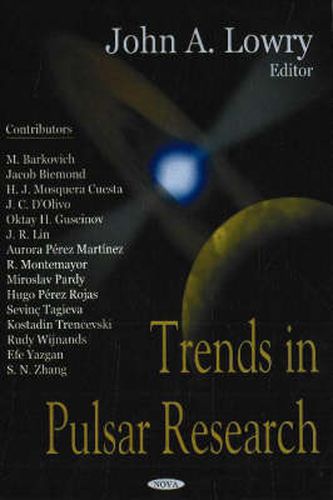Readings Newsletter
Become a Readings Member to make your shopping experience even easier.
Sign in or sign up for free!
You’re not far away from qualifying for FREE standard shipping within Australia
You’ve qualified for FREE standard shipping within Australia
The cart is loading…






Pulsars are stars, a significant part of whose observed energy output is not continuous but is emitted as distinct flashes or pulses of electromagnetic radiation. Many pulsars also emit some radiation weakly and constantly, forming a background for the more intensive pulses. Three distinct classes of pulsars are presently known to astronomers, according to the source of energy that powers the radiation: Rotation-powered pulsars, where the loss of rotational energy of the star powers the radiation X-ray pulsars, where the gravitational potential energy of accreted matter is the energy source, and Magnetars, where the decay of an extremely strong magnetic field powers the radiation. Although all three classes of objects are neutron stars, their observable behaviour and the underlying physics are quite different. There are, however, connections. For example, X-ray pulsars are probably old rotation-powered pulsars that have already lost most of their energy, and have only become visible again after their binary companions expanded and began transferring matter on to the neutron star. The process of accretion can in turn transfer enough angular momentum to the neutron star to recycle it as a rotation-powered millisecond pulsar.
$9.00 standard shipping within Australia
FREE standard shipping within Australia for orders over $100.00
Express & International shipping calculated at checkout
Pulsars are stars, a significant part of whose observed energy output is not continuous but is emitted as distinct flashes or pulses of electromagnetic radiation. Many pulsars also emit some radiation weakly and constantly, forming a background for the more intensive pulses. Three distinct classes of pulsars are presently known to astronomers, according to the source of energy that powers the radiation: Rotation-powered pulsars, where the loss of rotational energy of the star powers the radiation X-ray pulsars, where the gravitational potential energy of accreted matter is the energy source, and Magnetars, where the decay of an extremely strong magnetic field powers the radiation. Although all three classes of objects are neutron stars, their observable behaviour and the underlying physics are quite different. There are, however, connections. For example, X-ray pulsars are probably old rotation-powered pulsars that have already lost most of their energy, and have only become visible again after their binary companions expanded and began transferring matter on to the neutron star. The process of accretion can in turn transfer enough angular momentum to the neutron star to recycle it as a rotation-powered millisecond pulsar.